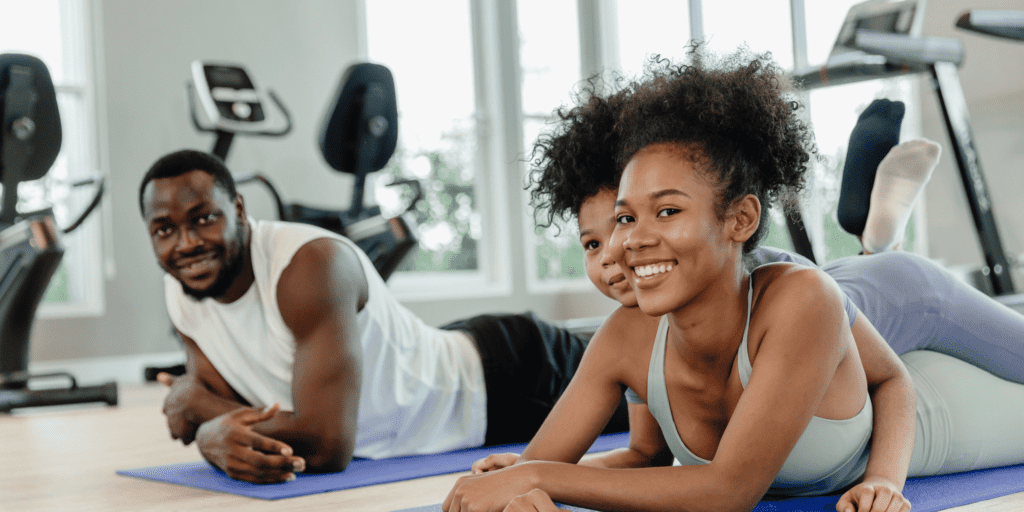How to Create Your Own Workout Routine:
Step-by-Step Plan & Exercises for Result

Creating a personalized workout routine is the key to achieving your fitness goals, whether it’s losing weight, building muscle, or improving overall health. A well-structured plan ensures your training is effective, sustainable, and safe. In this complete guide, we’ll walk you through the step-by-step process of designing a workout plan, including practical tips, detailed exercise examples, and common mistakes to avoid. Let’s get started!
Step 1: Assess Your Starting Point
Before starting any workout routine, it’s essential to assess your current fitness level. This is not just about knowing how much weight you can lift; it’s about understanding your body’s overall capabilities and limitations.
Start by evaluating your endurance with activities like running or cycling for a set duration. Test your strength with exercises such as push-ups or squats and see how many repetitions you can do with good form. Don’t forget flexibility—simple stretches will give you an idea of your range of motion.
This assessment will help you set realistic and measurable goals, such as ‘I want to increase my squat repetitions by 20% in the next 3 months.’ By knowing where you’re starting from, you can track progress effectively and avoid pushing your body too hard, which can lead to injuries.
It’s also worth revisiting your assessments periodically to adjust your workouts as your fitness level improves.
Step 2: Choose the Right Exercises for Your Goals
Once you’ve assessed your starting point and defined your goals, it’s time to choose exercises that align with your objectives.
If your primary goal is weight loss, you’ll want to incorporate a lot of cardiovascular exercises, such as running, cycling, or swimming, which are proven to burn fat and improve heart health. However, don’t neglect strength training; exercises like squats, lunges, and push-ups will help you preserve muscle mass while losing fat, ensuring that the weight you lose is primarily fat, not muscle.
For those focused on building muscle, resistance exercises should be your focus. Compound movements like deadlifts, bench presses, and rows stimulate multiple muscle groups at once, promoting muscle growth efficiently. If your goal is to improve your overall fitness and well-being, you’ll benefit from a mix of strength, cardio, and flexibility exercises.
Consider incorporating activities like yoga, Pilates, or bodyweight exercises to boost flexibility, core strength, and mental well-being. By balancing these different types of training, you’ll improve your body’s overall functional capacity and ensure long-term results.
Step 3: How Many Sets and Repetitions Should I Do?
The number of sets and reps you do depends on your goals:
- For Strength: 3-5 sets of 4-6 reps with heavier weights.
- For Hypertrophy (muscle growth): 3-4 sets of 8-12 reps with moderate weights.
- For Endurance: 2-3 sets of 15-20 reps with lighter weights.
Common Mistakes to Avoid:
- Using too much weight too soon, which can lead to poor form and injury.
- Not progressively increasing weight or resistance, resulting in stagnant progress.
- Skipping warm-ups, which increases the risk of muscle strain.
Step 4: How Long Should I Rest Between Sets?
Rest intervals between sets are important for maximizing results.
- For Strength: Rest for 2-5 minutes between sets.
- For Hypertrophy: Rest for 30-90 seconds.
- For Endurance: Rest for 20-60 seconds to maintain an elevated heart rate.
Why Rest Periods Matter:
- Too little rest can cause muscle fatigue and reduce performance.
- Too much rest can decrease workout intensity and slow down progress.

Step 5: How Much Weight Should I Lift?
Choosing the correct weight is key to avoiding injuries and ensuring progress:
- Test Your Limit: Choose a weight that challenges you on the last few reps but allows you to maintain proper form.
- Gradual Progression: As your body adapts, increase the weight to prevent stagnation.
Common Mistakes to Avoid:
- Lifting excessively heavy weights, compromising form and increasing injury risk.
- Not tracking progress, making it difficult to know when to increase resistance.
Step 6: What Is the Ideal Workout Duration?
The length of your workout depends on your experience and goals:
- Beginners: 30-45 minutes, 3-4 times a week.
- Intermediate/Advanced: 45-60 minutes, 4-6 times a week.
- HIIT Workouts: 20-30 minutes of high-intensity sessions can be very effective.
Maximizing Workout Efficiency:
- Plan workouts in advance to avoid wasting time.
- Focus on compound movements that target multiple muscle groups.
- Incorporate short rest periods to maintain intensity.
Step 7: How to Create Supersets and Circuit Workouts
Adding variety to your routine can increase intensity and save time. Two effective methods are supersets and circuit training.
1) Supersets:
A superset involves performing two exercises for opposing muscle groups without rest in between. Example: Perform a bench press (chest) followed by bent-over rows (back).
2) Circuit Training:
Circuit workouts combine several exercises with minimal rest. Example: Squats, push-ups, jump rope, crunches.
CrossFit-style exercises can add intensity to your circuits. If you’re interested in CrossFit, check out our guide on The Popularity of CrossFit: Benefits and Challenges for the Body
Step 8: How Many Days Per Week Should I Train?
The frequency of your workouts depends on your experience and goals:
- Beginners: 3-4 days per week with alternating rest days.
- Intermediate/Advanced: 4-6 days per week, dividing muscle groups by days.
Importance of Rest:
Ensure you allow 1-2 rest days for recovery. Active rest days with light activities like yoga or walking are also beneficial.
Creating your personalized workout routine doesn’t have to be complicated. With a well-structured plan, you can achieve your fitness goals efficiently and safely. Remember that consistency is key, and it’s essential to adjust your plan as needed, listen to your body, and maintain a balance between training and recovery.

Tips for Maximizing Your Fitness Journey:
Achieving long-term fitness success is not just about completing workouts but embracing a holistic approach that includes consistency, recovery, and mindful progress tracking. Here are some key tips to help you stay on track and maximize your results:
1. Set Clear and Achievable Goals
Establish specific, measurable, and time-bound goals, such as “I will increase my bench press by 20 pounds in 3 months” or “I want to lose 5% body fat in the next 8 weeks.” This not only keeps you motivated but also helps you track progress in a tangible way. Break down larger goals into smaller milestones to celebrate small victories along the way.
2. Track Your Progress Consistently
Keep a fitness journal or use a workout tracking app to record your exercises, weights, reps, and how you feel during each session. This allows you to see your improvements over time and identify areas that need attention. Regular tracking also helps prevent stagnation by showing you when it’s time to increase intensity or change up your routine.
3. Focus on Proper Nutrition
Exercise alone won’t lead to significant results if it’s not paired with proper nutrition. Fuel your body with a balanced diet rich in lean proteins, complex carbohydrates, healthy fats, and plenty of fruits and vegetables. Ensure you’re eating enough to support your activity level and goal—whether it’s muscle building or fat loss. Hydration is key too, so drink water consistently throughout the day.
4. Prioritize Recovery and Rest
Recovery is just as important as the workout itself. Without adequate rest, your muscles won’t repair and grow, and you risk overtraining. Ensure you get enough sleep—aim for 7-9 hours per night—and take regular rest days to allow your body to recharge. Active recovery, such as light yoga, walking, or stretching, can also help reduce soreness and improve flexibility.
5. Vary Your Workouts to Avoid Plateaus
Your body can quickly adapt to the same routine, leading to a plateau in progress. To prevent this, vary your workouts by changing the types of exercises you do, the intensity, the number of sets and reps, or the frequency of your sessions. Try new forms of exercise, such as swimming, cycling, or yoga, to keep things fresh and challenge your muscles in different ways.
6. Stay Consistent and Be Patient
Fitness is a long-term commitment. Consistency is key to seeing progress. Even when motivation is low, it’s important to stick to your routine. Results take time, and patience is necessary. Don’t get discouraged by short-term setbacks or minor mistakes—embrace the process, and remember that every small effort brings you closer to your goals.
7. Get a Workout Buddy or Join a Community
Training with a partner or being part of a fitness community can provide both accountability and motivation. Whether you join a local gym, participate in a fitness class, or find a workout buddy, social support can make your fitness journey more enjoyable and consistent. You’ll push each other to stay on track, and sharing your wins along the way will help maintain enthusiasm.
8. Listen to Your Body and Adjust Accordingly
While pushing through challenges is part of the fitness journey, it’s also crucial to listen to your body. If you’re feeling pain (not just discomfort), it could be a sign to back off or modify your workout. Pushing through pain can lead to serious injuries and setbacks. Pay attention to signs of fatigue or overtraining and allow your body to rest when needed.
9. Celebrate Your Progress and Reward Yourself
Celebrate each milestone, big or small. Whether it’s lifting heavier weights, running a longer distance, or simply sticking to your routine for a month, take time to acknowledge your hard work. Rewarding yourself—whether with a healthy treat, new workout gear, or a relaxing activity—helps reinforce positive habits and keeps you motivated.
10. Stay Adaptable and Keep Learning
Your fitness journey is unique, and it’s essential to stay open to trying new approaches. Don’t be afraid to adapt your plan as needed, whether that’s changing exercises, adjusting nutrition, or modifying goals. Keep educating yourself about fitness, nutrition, and recovery strategies. Knowledge is power, and staying informed will help you make smarter decisions for your body.
Sources:
- American Council on Exercise (ACE). “How to Create an Effective Workout Plan.” ACE Fitness. Available at: https://www.acefitness.org/
- Mayo Clinic. “Exercise: How to Get Started.” Mayo Clinic. Available at: https://www.mayoclinic.org/
- National Institute of Diabetes and Digestive and Kidney Diseases (NIDDK). “Physical Activity for a Healthy Weight.” Available at: https://www.niddk.nih.gov/
- Harvard Health Publishing. “Strength Training Builds More Than Muscles.” Harvard Medical School. Available at: https://www.health.harvard.edu/
- American College of Sports Medicine (ACSM). “Resistance Training for Health and Fitness.” ACSM. Available at: https://www.acsm.org/
- Centers for Disease Control and Prevention (CDC). “Physical Activity for Everyone: Guidelines & Recommendations.” CDC. Available at: https://www.cdc.gov/
- The Essential Empire. “The Popularity of CrossFit: Benefits and Challenges for the Body.” Available at: https://theessentialempire.com/the-popularity-of-crossfit/
- The Essential Empire. “High-Intensity Interval Training: A Complete Guide.” Available at: https://theessentialempire.com/high-intensity-interval-training/
